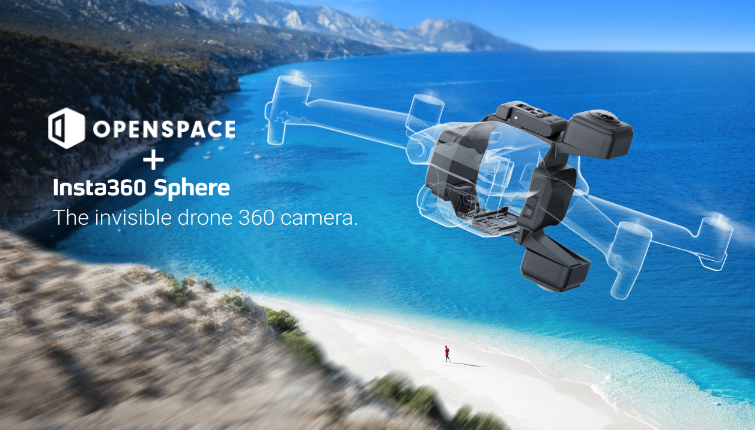Supporting the use of 360° cameras, drone cameras, mobile cameras, lidar scanners, and more, OpenSpace is now adding support to Insta360’s Sphere camera to simplify and improve user experience, as well as empower them to capture whatever they choose.
Priced at $429.99 and compatible with DJI’s Mavic Air 2 and Air 2S, the Sphere camera features a 6080x3040 photo resolution, a video resolution of up to 5760x2880 at 30 fps, 48-minute battery life, weighs 192g, and is compatible with iOS and Android devices. However, when you visit the product’s webpage, Insta360 markets the Sphere as a consumer product towards cinematic content by offering features like Horizon Flip, Tiny Planet, Sky Transition, and more. So, why did OpenSpace choose this camera to improve its platform?
Apart from being incredibly easy to use, the Sphere comes with one upward and one downward-facing camera, turning the drone “invisible” in the footage it captures - hence why Insta360 calls it the “invisible drone 360 camera”. As a result, users can seamlessly capture high-resolution footage of the job site without worrying about editing the drone body out of the images. “Ease of use is at the core of OpenSpace’s platform,” says Neel Sheth, VP of Product at OpenSpace.
“Our customers have been attaching cameras to drones for years, and our dedicated support for Sphere will simplify and improve their experience. We want OpenSpace customers to be able to capture in a way that aligns with their workflows and goals, and extending our drone support through this partnership will further enable exterior captures to be seamlessly integrated into our platform.”
Additionally, as pointed out by Chris Balandran, Direct of Marketing at OpenSpace, Sphere has an easy locking mechanism and FlowState stabilization that delivers smooth footage. “This functionality also makes way for less experienced drone pilots to achieve quality captures and eliminates the need for reflights,” Balandran wrote.
“We expect our integration with Sphere to get even better as we continue to beta test with a select group of customers. Support for Sphere will be generally available to customers in the near future.”
As a reality capture software, OpenSpace Capture allows users to map worksites by simply attaching a 360º camera to a hard hat, a drone, robot or using lidar-enabled iOS devices, and walking/flying around it, capturing up to 150,000 square feet per hour. Vision Engine, the company’s proprietary and patent-pending solution, uses computer vision and SLAM methods to automatically map collected data to project plans and align features in overlapping images to calculate camera position and generate a sparse 3D point cloud of a project. Also, whenever there’s a site survey, the Vision Engine’s Machine Learning algorithms learn more about the captured 3D environment, aligning and mapping the images faster and more accurately. Plus, site image maps are typically ready to view about 15 minutes after upload.
Complementing the capturing part of the platform, OpenSpace Track (previously known as ClearSight) quantifies job site progress automatically while staying on schedule and budget. The platform also uses AI and computer vision to provide real-time feedback across the whole project, from confirming percent completeness, measuring production rates, and tracking project activity to visualizing progress in BIM or instantly verifying work-in-place for any area or zone in 3D.
In 2023, OpenSpace believes we’ll continue to see 360° cameras as the primary tool for capturing job sites. In a survey the company conducted, 47% of the survey respondents are also looking towards the availability of more lidar scanners in personal tech, drones, robots, and small wearable 360º cameras to seamlessly capture their daily activities on the job site.
“With highly specialized robots on job sites, builders will be able to automate time-consuming or complex tasks, allowing them to focus on more strategic responsibilities and other jobs that only a skilled human worker can complete,” CEO at OpenSpace, Jeevan Kalanithi’s blog post reads. “Additionally, drones will be used to capture areas that may be difficult for a builder to capture, such as exteriors and confined areas.”






